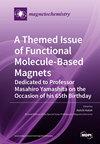多孔炭基体热分解沉淀铁(II)前驱体制备多孔活性炭的吸附性能
IF 2.5
4区 化学
Q2 CHEMISTRY, INORGANIC & NUCLEAR
引用次数: 0
摘要
利用材料的磁性创造具有高吸附和催化性能的新化合物是磁化学的重要领域之一。由于使用惰性气氛和难以湿法沉淀磁铁矿,磁性碳质吸附剂的典型合成方案相当复杂。出现的实验问题阻碍了磁性活性炭的工业生产。为了克服这些障碍,我们提出了一种新的多孔碳方法:基于铁(II)盐在多孔碳上沉淀并随后热解的磁铁矿复合合成。我们在材料清洗阶段为这一过程提供了便利。所用的合成路线简单,可在工业上应用。本文主要研究了由商用活性炭BAU-a和AG-3制备的产物的吸附性能。用低温氮吸附研究了多孔结构,结果表明,随着中孔体积的增加,BAU-A的表面积减少了26%,AG-3的表面积降低了40%。用BAU-A制备的磁性炭对水溶液中的苯酚和硝基苯进行了吸附实验。利用Langmuir模型很好地描述了所获得的吸附等温线。磁性多孔碳的情况下的极限吸附值低于原始碳的情况。极限吸附值的相对降低接近比表面积的相对降低。吸附常数不变,表明多孔磁性炭及其活性炭前驱体对苯酚和硝基苯的吸附中心相同。因此,我们在本研究中表明,我们开发的磁性活性炭几乎保留了其活性炭前体的吸附性能。本文章由计算机程序翻译,如有差异,请以英文原文为准。
The Adsorption Performance of Porous Activated Carbons Prepared from Iron (II) Precursors Precipitated on the Porous Carbon Matrix Thermolysis
The creation of new compounds featuring high adsorption and catalytic performance with magnetic properties of the material is one of the important fields of magnetochemistry. The typical synthetic schemes of magnetic carbonaceous adsorbents are rather complicated due to the use of inert atmosphere and difficult wet methods of magnetite precipitation. The arising experimental issues prevent industrial production of magnetically activated carbons. In order to overcome these obstacles, we suggested a novel approach to porous carbons: magnetite composite synthesis based on iron (II) salt precipitation on porous carbon and subsequent thermolysis. We facilitated the process at the stage of the material washing. The synthetic route used is simple and can be applied industrially. The present paper is focused on the adsorption performance of a product prepared from commercial activated carbons BAU-A and AG-3. The porous structure was studied with low-temperature nitrogen adsorption that revealed surface area decreased by 26% in the case of BAU-A and 40% in the case of AG-3 with an increase in mesopore volume. Phenol and nitrobenzene adsorption from water solution was tested with magnetic carbon prepared from BAU-A. The adsorption isotherms obtained are described well using the Langmuir model. The limiting adsorption value in the case of magnetic porous carbon is lower than in the case of pristine carbon. The relative decrease in limiting adsorption value is close to the relative decrease in the specific surface area. The adsorption constant remains the same, showing that adsorption centers of phenol and nitrobenzene are the same for porous magnetic carbon and its activated carbon precursor. Thus, we showed in the present study that the magnetically activated carbons we developed almost retain the adsorption performance of their activated carbon precursors.
求助全文
通过发布文献求助,成功后即可免费获取论文全文。
去求助
来源期刊

Magnetochemistry
Chemistry-Chemistry (miscellaneous)
CiteScore
3.90
自引率
11.10%
发文量
145
审稿时长
11 weeks
期刊介绍:
Magnetochemistry (ISSN 2312-7481) is a unique international, scientific open access journal on molecular magnetism, the relationship between chemical structure and magnetism and magnetic materials. Magnetochemistry publishes research articles, short communications and reviews. Our aim is to encourage scientists to publish their experimental and theoretical results in as much detail as possible. Therefore, there is no restriction on the length of the papers. The full experimental details must be provided so that the results can be reproduced.
 求助内容:
求助内容: 应助结果提醒方式:
应助结果提醒方式:


